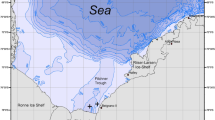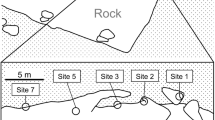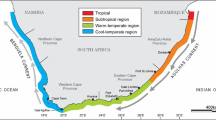Abstract
Three species of hamlets, Hypoplectrus chlorurus, H. unicolor, and H. puella (Pisces: Serranidae) were observed underwater off the west coast of Puerto Rico. They are predaceous fishes, feeding on small benthic organisms, and live in close association with the coral reef. Hamlets are highly aggressive and defend large territories, excluding their own and all other species of hamlets. They are synchronous hermaphrodites. In spawning, which occurs around sunset, one member of the pair ascends, the other joins it, each clasps the nape of the other with its tail, and gametes are released. Little color change occurs, but the black marking before the eye of H. unicolor fades when fixing on prey, proving it is not used as a sighting line. The all-black nominal species H. nigricans spawns with the yellow-tailed H. chlorurus, and is regarded here as a synonym of H. chlorurus.
Similar content being viewed by others
Literature cited
Barlow, G.W.: Ethology of the Asian teleost Badis badis. III. Aggressive behavior. Z. Tierpsychol. 19, 29–55 (1962)
—: Effect of size of mate on courtship in a cichlid fish, Etroplus maculatus. Communs behav. Biol. (Part A) 2, 149–160 (1968)
—: A test of appeasement and arousal hypotheses of courtship behavior in a cichlid fish, Etroplus maculatus. Z. Tierpsychol. 27, 779–806 (1970)
—: The attitude of fish eye-lines in relation to body shape and to stripes and bars. Copeia 1972, 4–12 (1972)
—: On the sociobiology of four Puerto Rican parrotfishes (Scaridae). Mar. Biol. 33, 281–293 (1975)
— and R.F. Green: The problems of appeasement and of sexual roles in the courtship behavior of the blackchin mouthbreeder, Tilapia melanotheron (Pisces: Cichlidae). Behaviour 36, 84–115 (1970)
Böhlke, J.E. and C.G. Chaplin: Fishes of the Bahamas, 771 pp. Wynnewood, Pennsylvania: Livingston 1968
Clark, E.: Functional hermaphroditism and selffertilization in a serranid fish. Science, N.Y. 129, 215–216 (1959)
—: Mating of groupers. Nat. Hist., N.Y. 74, 22–25 (1965)
Ficken, R.W., P.E. Matthiae and R. Horwich: Eye marks as an aid to vision. Science, N.Y. 173, p. 936 (1971)
Ghiselin, M.T.: The evolution of hermaphroditism among animals. Q. Rev. Biol. 44, 189–208 (1969)
Lorenz, K.: On aggression, 306 pp. London: Methuen 1966
Myrberg, A.A., Jr. and R.E. Thresher: Interspecific aggression and its relevance to the concept of territoriality in reef fishes. Am. Zool. 14, 81–96 (1974)
Ogden, J.C. and N.S. Buckman: Movements, foraging groups, and diurnal migrations of the striped parrotfish Scarus croicensis Bloch (Scaridae). Ecology 54, 589–596 (1973)
Randall, J.E.: Caribbean reef fishes, 318 pp. Neptune City, New Jersey: T.F.H. Publications 1968
Smith, C.L.: The patterns of sexuality and the classification of serranid fishes. Am. Mus. Novit. 2207, 1–20 (1965)
Author information
Authors and Affiliations
Additional information
Communicated by J.S. Pearse, Santa Cruz
Rights and permissions
About this article
Cite this article
Barlow, G.W. On the sociobiology of some hermaphroditic serranid fishes, the hamlets, in Puerto Rico. Marine Biology 33, 295–300 (1975). https://doi.org/10.1007/BF00390567
Accepted:
Issue Date:
DOI: https://doi.org/10.1007/BF00390567




